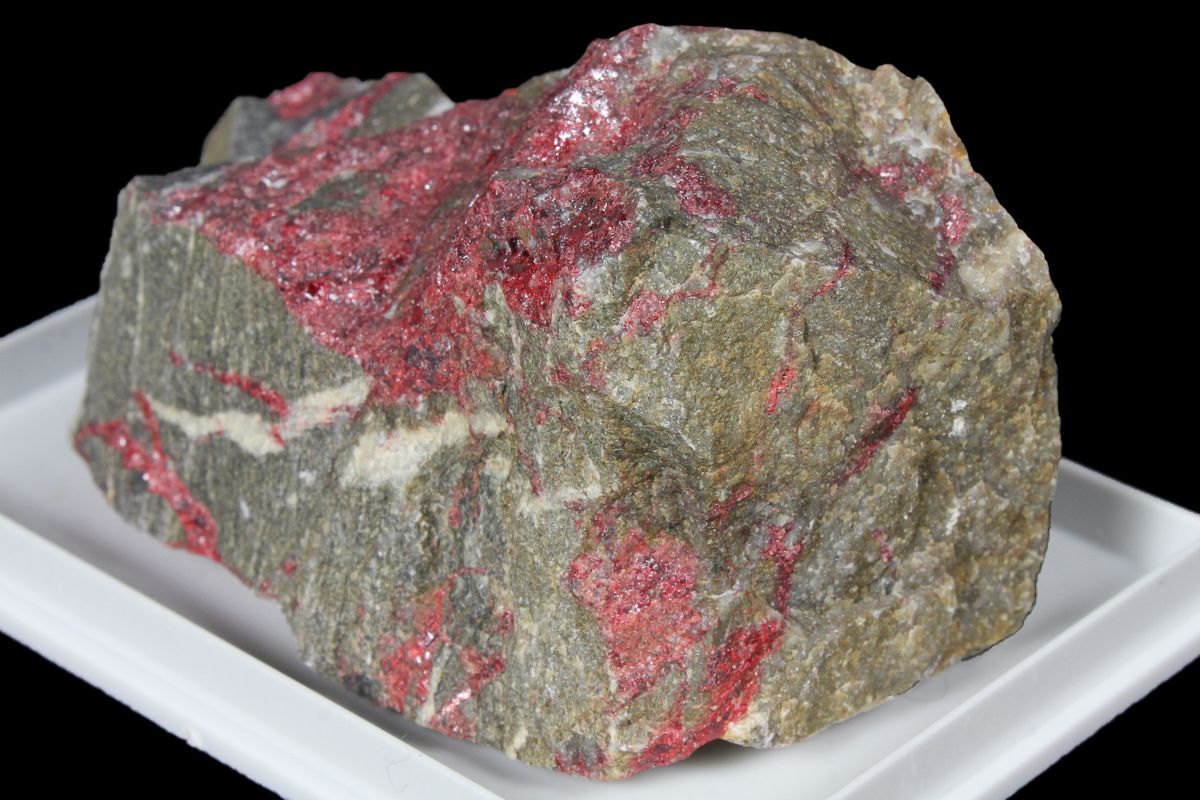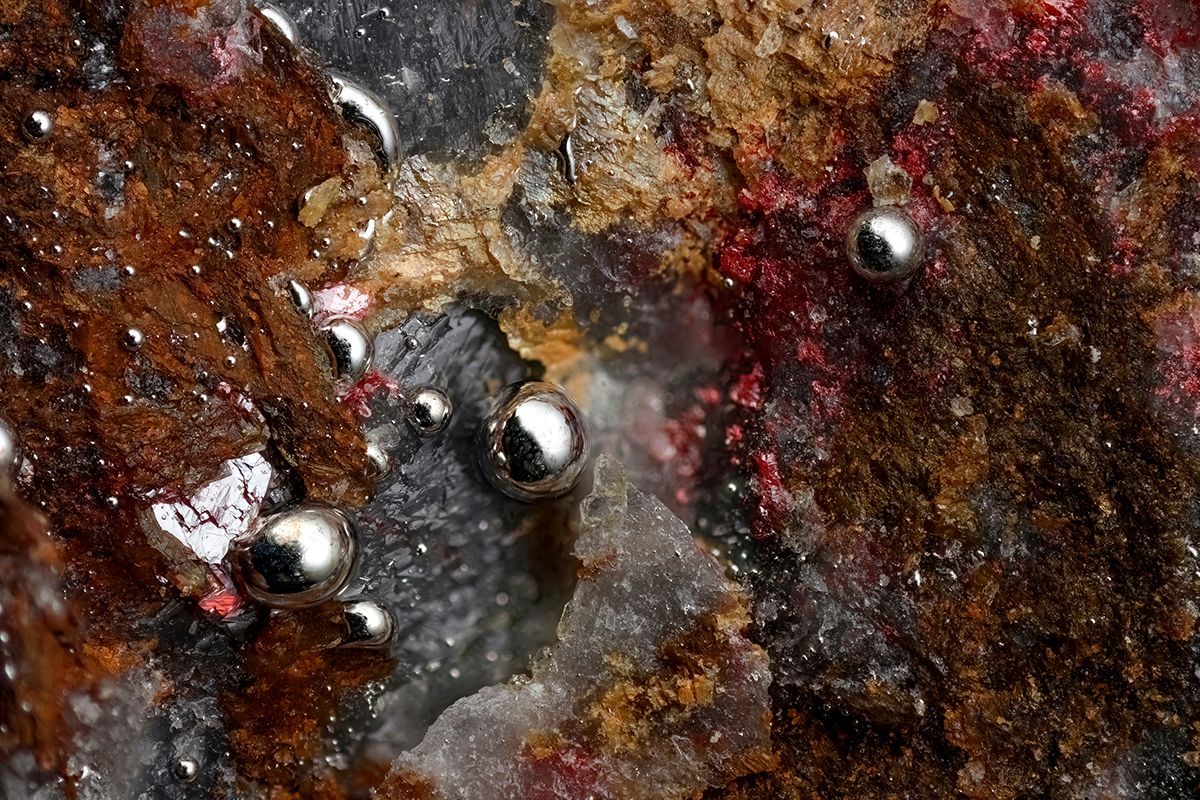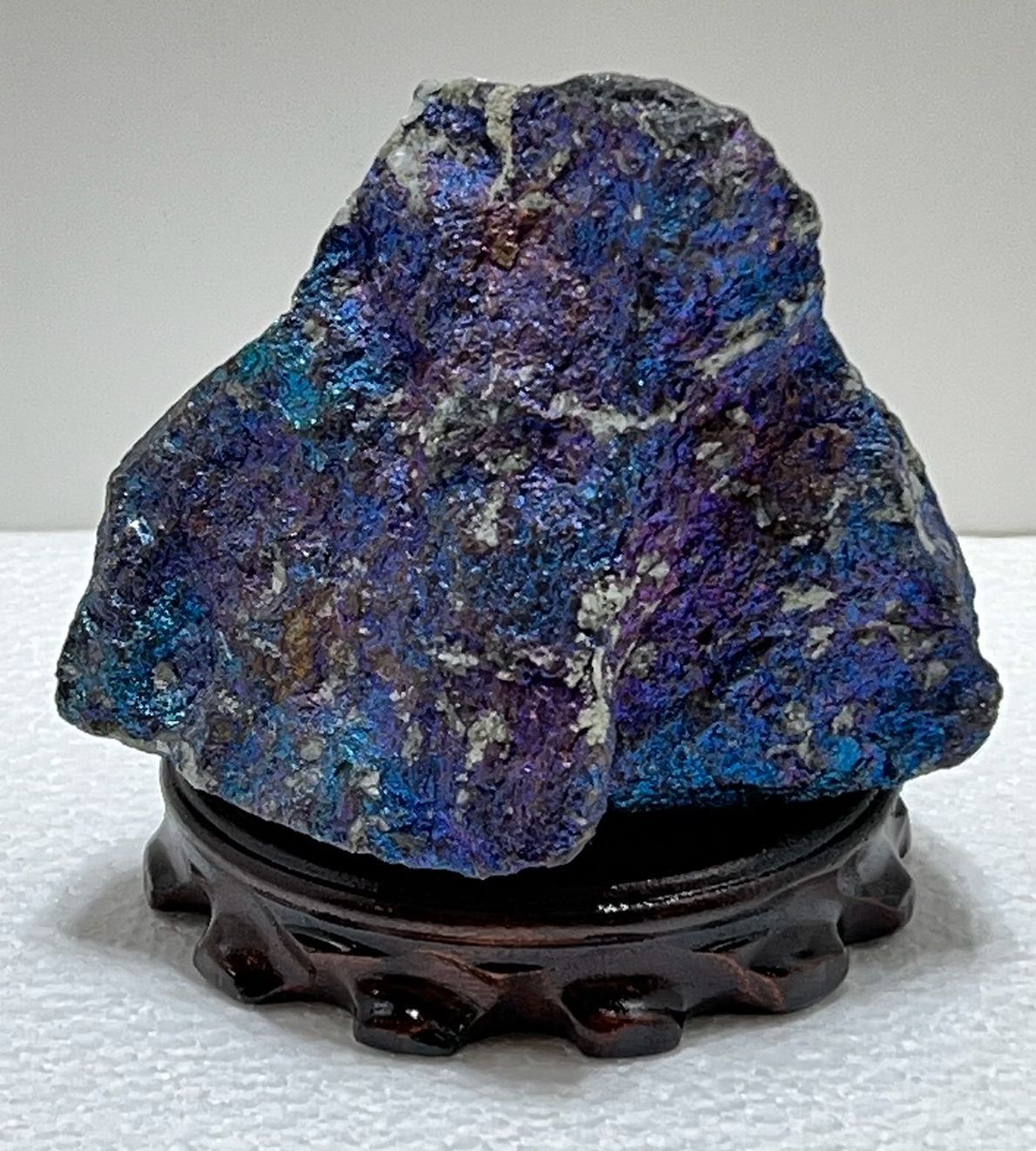Please, Don’t Kiss the Cinnabar!
A detailed illustrated discussion of stones and minerals that are toxic under certain conditions
By W. Steve Tait, Ph.D., December, 2023
“A viewing stone connoisseur is well versed in all aspects of viewing stone appreciation!” Dr. Tom Elias.
During the 50 years Sue and I have been collecting stones and minerals, we’ve encountered numerous rock shops that sell toxic stones without realizing the stones are beautiful-but-deadly! It’s ironic that some of the most beautiful stones are sometimes the deadliest.
It’d be disingenuous to say we don’t have any toxic viewing stones in our collection. For example, we have multiple malachite specimens (classified highly toxic), and recently added a large Eudialyte specimen (classified medium toxic) to our collection.
In other words, don’t panic! Most viewing stones are safe when properly handled, and only become toxic when cutting or polishing, during heating, or when cleaning with acids.
What makes stones toxic?
There are three criteria for mineral and stone toxicity classifications 1) normal handling, 2) cutting and polishing, and 3) ingestion. Ingestion could occur by skin contact, breathing or swallowing dust and small pieces of a stone.
Stones are toxic when one or more of their minerals contain toxic elements. The Occupational Safety and Health Administration (OSHA) publishes a list of toxic metals that is referenced at the end of this paper. The National Institute of Health (NIH) is also a good reference source for various toxic elements that make up your stones.
Ingestion can occur by breathing and swallowing stone dust. Hence, part of stone toxicity is determined by how easily it generates dust. A measure of dust-generation-ease is the Mohs hardness scale (see photo).
Soft stones have Mohs harnesses less than 3, typically cannot be polished, and have a high tendency to produce dust while handling.
Moderately hard stones having a Mohs hardness between 3 to 6, typically can be polished but will generate dust while being polished.
Hard stones having Mohs hardness greater than 6 typically can be polished to a smooth finish and generate little or no dust while handling.
Radioactive metals like uranium, yttrium and thorium are rare, and have lethal dose levels of 400 to 450 rems (4 to 5 sieverts). Radioactivity can damage, kidneys, liver, lungs, and bones without either dust ingestion, or skin contact. Uranium fluoresces green, but the most positive way to know if a stone like Uranium is radioactive is with a Geiger counter.
I’m assuming viewing stone collectors don’t purposely or accidentally swallow pieces of stones or make stone water tinctures for drinking. Hence, this paper will only discuss toxicity by ingesting or inhaling stone dust and ingestion via skin contact.
Examples of toxic viewing stones
There are currently 5,975 known minerals that can be found in various stones either singularly, or in combinations. Hence, we’ll discuss the more common toxic stones composed of the metals listed in an OSHA table (referenced at the end of this paper), plus a few other relatively lower toxicity metals, like antimony, and titanium.
Cinnabar is mercury sulfide (HgS) and is rated as High Toxicity, because of the mercury (Hg) in this mineral. While pure cinnabar is relatively non-toxic, heating it at or above 235 oC causes complete decomposition to elemental mercury (Hg) and sulfur. Incomplete decomposition of cinnabar also occurs at room temperature.

Cinnabar crystals on a green host stone—might be either serpentine, or green chalcedony (microcrystallin quartz).
Mercury droplets could be present on this cinnabar specimen, but are too small to see without a microscope.

This photomicrograph shows mercury droplets on cinnabar, with siderite (yellow crystals) & quartz (clear crystals). The mercury droplets have diameters ranging from approximately 0.004 mm to 0.07 mm. Human hair is approximately 0.019 mm thick.
Cinnabar is soft, difficult to polish, and can produce dust when handling (Mohs hardness is 2 to 2.5). Liquid mercury absorbs through the skin and also evaporates to produce toxic mercury vapor. Consequently, cinnabar ingestion occurs from skin contact, breathing vapors, breathing and swallowing dust.
The lethal dose for mercury is reportedly between 6 milligrams (mg) and 200 mg of mercury per kilogram (kg) of body mass, depending on how it is ingested.
Lower
mg-per-kg doses are
more lethal
than
higher
doses. Mercury from cinnabar can damage the gastrointestinal tract, central nervous system, and the kidneys.
Stibnite is antimony sulfide (Sb2S3) and is rated as High Toxicity.
Stibnite contains antimony (Sb) and has been portrayed by the popular media as among the deadliest minerals in the world. However, it doesn’t have a reported lethal dose.
Antimony has been reported as causing severe stomach pain with vomiting, when a non-lethal 0.5 mg is ingested per kg of body mass.
Stibnite is soft, difficult to polish, and thus can produce dust during handling (Mohs hardness 2).
Stibnite enters the body through dust ingestion.

Realgar, aka Chinese Chicken Bloodstone, is arsenic sulfide (As4S4). Realgar is rated as High Toxicity because it contains arsenic (As).
It is a very soft stone, difficult to polish, and thus can produces dust during handling (Mohs hardness of 1.5 to 2). Arsenic enters the body both through skin contact and ingesting dust. The lethal dose for arsenic is 13 mg per kg of body mass. Arsenic damages the bladder, the central nervous system, and the lungs.
Galena is Lead sulfide (PbS) and is rated as High Toxicity because it contains lead (Pb).
Galena is soft, difficult to polish, and thus can produce dust during handling (Mohs hardness 2.5 to 2.75).
Lead enters the body by ingesting dust. Its lethal dose is reported as 4,665 mg per kg of body mass (much less lethal than Arsenic).
Lead damages the brain and the central nervous system.
Various internet sites have contradictory toxicity classifications for some stones. For example, different websites list malachite and pyrite as having both high and low toxicity.
Malachite is hydrated copper (Cu) carbonate (Cu2(CO3)(OH)2). It has a Mohs hardness ranging from 3 to 3.5 and can be polished. Malachite can be rated as either high, or low toxicity depending on whether or not it has a smooth polish.
The left malachite viewing stone is a fibrous malachite composed of small acicular needle-crystal clusters. Fibrous malachite cannot be polished and is rated High Toxicity because it produces dust. The right viewing stone has a smooth surface (polished) and is rated Low Toxicity because it does not produce dust.
Fibrous malachite viewing stone (acicular crystal clusters) and
Malachite viewing stone with a smooth surface (polished)
The Fibrous malachite viewing stone is composed of small acicular needle-crystal clusters. Fibrous malachite cannot be polished and is rated High Toxicity because it produces dust. The polished viewing stone has a smooth surface and is rated Low Toxicity because it does not produce dust.
Eudialyte is rated as Medium Toxicity. Eudialyte is a complex zirconium silicate, with a chemical formula of Na15Ca6Fe3Zr3Si(Si25O73)(O,OH,H2O)3(Cl,OH)2.
Zirconium (Zr) has two rare radiative isotopes that can make it radioactive when present, hence a medium toxicity rating. Zirconium can also be radioactive when contaminated with other radioactive elements like uranium and hafnium.
This pink eudialyte is in a host rock consisting of biotite (black mica) with a thin vein of weathered gold mica between the Eudialyte clusters.
Eudialyte’s pink color is from iron in the Eudialyte crystal lattice.
Eudialyte is a hard mineral that can be polished to a smooth finish (Mohs hardness of 5 to 6).
Our collection has several Eudialyte specimen like the large one in this photo; all of which are not radioactive.
We travel with a hand-held Geiger counter to ensure those fabulous stones we find are not radioactive.

Chalcopyrite (aka peacock stone) is a distant cousin to pyrite (aka fool’s gold-FeS), and a major source of commercial copper ore.
It can have a multi-colored iridescent appearance like the stone in this photo.
The chemical formula for chalcopyrite is CuFeS2. It is medium-hard and can be polished (Mohs hardness 3.5 to 4, like malachite).
Chalcopyrite toxicity is not listed in the resources cited for this paper. However, the laboratory safety data sheet (SDS) for laboratory-chalcopyrite lists it as a slight health hazard with 1-acute effects.
This rating indicates chalcopyrite causes irritation or minor, reversible injury on contact with eyes, skin, mucous membranes, or upper respiratory tract. In other words, chalcopyrite dust ingestion can cause irritation and reversible injury; so, handle it with the appropriate PPE and ventilation and you can enjoy displaying your chalcopyrite viewing stone as long as it’s not generating dust.
Hazards from heating, cutting and polishing stones, and acid cleaning
Cutting and polishing stones produces dust and fibers, and heating stones could produce toxic gases. For example:
Dust hazards from stones are:
- Silica stone dust such as amethyst, clear quartz, and rose quartz absorbs into lung tissue and cause silicosis.
- Serpentines contain asbestos minerals that produce fibers that cause fibrosis
Heating hazards are:
- Heating fluorite produces toxic fluorine gas. Fluorite dust also causes fluorosis that can damage kidneys and liver, and cause neurological problems
- Heating pyrite produces toxic sulfur dioxide and sulfuric acid
- Stones with entrapped water and/or air may explode when heated
Acid hazards:
- Mineral acids, such as muriatic acid (dilute hydrochloric acid), and nitric acid
- Organic acids such as vinegar and sulfamic acid produce toxic vapors
Acid vapors cause eye, nose, and respiratory tract irritation; and prolonged breathing can damage lungs and even cause death. Acids also burn unprotected skin. Consequently, acid-cleaning stones requires both the appropriate PPE, and a high level of ventilation.
Viewing Stone Safe Handling Practices
The secret to safe handling of hazardous materials is using the appropriate personal protection equipment (PPE), which includes neoprene gloves, safety glasses, dust masks, respirators, protective aprons and the proper amount of ventilation.
The secret to safe handling of radioactive minerals/stones is to stay away from them!
There are several Dos-and-Don’ts guidelines for the safe handling of all viewing stones. I recommend practicing these guidelines both with low toxicity rated viewing stones and when the mineralogy of a viewing stone is unknown. It’s always better to be safe-than-sorry!
Don’t
- Don’t collect radioactive stones—safe handling of radioactive stones is very difficult to achieve by anyone other than government and commercial laboratories
- Don’t heat stones in an oven or with a flame—heat can decompose stone minerals, thereby producing toxic gases and acids
- Don’t cut or polish stones without the appropriate PPE and ventilation
- Don’t breath dust from any stone
- Don’t touch stones with bare hands when the stone is known to have metals that absorb through the skin (also a good guideline for any stone whose mineral composition is unknown)
Do
- Check for the radioactivity of stones that are potentially radioactive, before adding the stone to your collection
- Wear PPE when handling unknown stones (always better-safe-than-sorry)
- Wear PPE when handling stones that are known to be toxic, and any soft stone that generates dust
- Use plenty of ventilation when cutting and polishing stones, and when using acid to clean stones
- Wash your hands after handling any stone, even when you wear PPE during handling
- Display soft, unpolished, dusty stones in a transparent enclosure (Mohs hardness less than 3)
Note that the above guidelines are not exhaustive. Please also see the references below for more complete guidelines on stone toxicity, and how to safely handle stones.
I’m not suggesting removing any toxic viewing stones from your collection, unless they are radioactive. However, I recommend not adding high-toxicity stones to a collection, and specifically recommend not adding radioactive stones to a collection.
I hope you find this article useful for both your continued and safe collection of viewing stones.
REFERENCES
The references for this paper have embedded weblinks for convenient access:
Occupational Safety and Health Administration (OSHA) OSHA toxic metals
National Institute of Health (NIH) NIH National Library of Medicine
National Park Services (NPS) Health Hazards with Geological Specimen NPS geological specimen health hazards
Mindat lists information on virtually all the 5,975 known minerals. The link for this site is: Mineral Data
The Mindat mineral health information is in the “Other Information” section, found by scrolling toward the bottom of each listing.
The Mindat website is also helpful for identifying viewing stone minerals. It has extensive information for each mineral/stone with over 1,300,000 photos on virtually all known minerals. The site also lists 3000-plus rock names, and trade names for rocks and minerals.
The International Gem Society (IGS) has an online list of mineral toxicities. The link to the IGS Table is: IGS toxicity table
A few notes about the IGS Table;
- it has 3 columns of information. The first two columns list the mineral/stone names and their toxicity rating, respectively
- Several stones in the IGS Table appear to have nonsensical toxicity ratings.
- However, the third column explains the reasoning for assigning a given rating.
For example, in the third column for:
- Lithified organic stones like jet and amber are rated as high toxicity because of their potential for bioactivity (presumably when swallowed)
- Various silica stones, such as quartz, amethyst, wax stone, and some silicate stones, such as nephrite have high toxicity ratings because dust generated during cutting and polishing could cause silicosis
- Stones like serpentine are also rated as high toxicity because they contain asbestos. Fiber-dust generated during cutting, polishing, and from unpolished samples could cause fibrosis
Thus, these 3 stones are probably not considered high toxicity during normal handling, unless they are unpolished and produce dust while handling.
The third column in the IGS table also notes which acid-soluble stones could produce dangerous reactions when swallowed. Dangerous reactions could include dissolving by stomach acid that produces gas, could cause high temperatures, and could make toxic minerals water soluble—dissolves more readily in the blood stream.
Books that discuss rocks with gemstones and minerals are also an important resource for identifying the minerology of your viewing stones. The Smithsonian has sponsored several rock/gemstone/mineral books, such as Rock and Gem written by Ronald Louis Bonewitz (published by DK publications).
ACKNOWLEDGEMENTS
Many thanks to Dr. Susan Whitworth Tait and Dr. Tom Elias for their thoughtful event with thanks also to those who either provided photographs, or granted permission to include their copyrighted photographs in this paper:
- Realgar (Chinese chicken bloodstone) and malachite, copyright photos provided by Dr. Tom Elias
- Mercury on cinnabar, copyright photomicrograph provided by Professor Martin Stevko, Earth Science Institute, Slovak Academy of Sciences
Cinnabar on green host stone, copyright photo provided by Matt Heaton at
FossilEra.com

